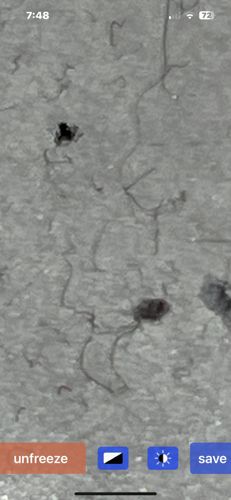Threadworm (likely a type of parasitic nematode)
Scientific Name: Scientific name varies greatly by species, e.g., Strongyloides stercoralis (a common human threadworm). It is not possible to determine the exact species from the image.
Order & Family: Order: Strongylida (or other orders within Nematoda, depending on specific species), Phylum: Nematoda (often referred to as roundworms). Specific family is hard to determine without more detail, but could be Strongylidae, Ancylostomatidae, etc.
Size: Microscopic to several millimeters in length, depending on the species. Larvae are often microscopic, while adult worms can be visible but still very small and thin (thread-like).

Natural Habitat
Internal parasites, living within the gastrointestinal tract, lungs, or other organs of various animals, including humans. Outside of a host, their eggs or larvae may be found in soil, water, or on vegetation.
Diet & Feeding
Threadworms are internal parasites and feed on the bodily fluids, tissues, and digested food of their hosts. The exact diet varies depending on the species and the host they inhabit.
Behavior Patterns
Threadworms are parasitic and spend their lives within a host. They typically reproduce internally, with larvae being expelled through feces to infect new hosts. Their life cycle can be direct (one host) or indirect (involving intermediate hosts).
Risks & Benefits
Risks: Threadworms are significant parasites causing a range of diseases in humans and animals, known as strongyloidiasis or other helminth infections. Symptoms can range from mild gastrointestinal upset to severe malnutrition, anemia, organ damage, and even death in heavy infections or immunocompromised individuals. Benefits: None for humans; ecologically, they are part of complex food webs and disease dynamics in natural ecosystems, though this is not a 'benefit' to the host.
Identified on: 8/28/2025